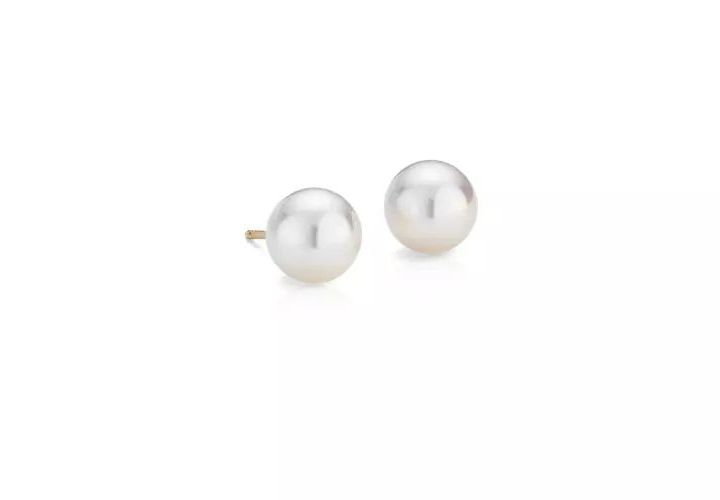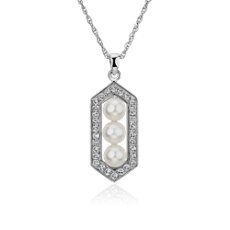Terms & Conditions
> SHOP JEWELRYWHAT IS A PEARL?
A treasure born from rivers, lakes and seas, pearls form in the bodies of certain mollusks when an irritant like sand enters their shell. Over time, the mollusk coats the irritant with layers of protein, called nacre, to create a beautiful, lustrous jewel.

What's the difference between natural pearls and cultured pearls?
Natural pearls form entirely without human intervention, making them incredibly rare—and considerably more valuable than cultured pearls. Over the last century, natural pearls have become even more scarce, leading to the fascinating science of pearl cultivation.
Cultured pearls form inside the body of a mollusk. However, technicians help the process along by inserting a man-made irritant to stimulate the creation of nacre. The resulting gemstone is far more affordable and is as authentic and beautiful as a natural pearl. The majority of pearls on the market today are of the cultivated variety.
How to Choose a Pearl
When it’s all boiled down, the best advice we can give you about how to pick a pearl is to choose the one that makes you feel like a million bucks when you’re wearing it. Here are some things to look for when you’re pearl shopping.
Size
Pearls are measured in millimeters, typically ranging from 5 to 16mm. Freshwater pearls are usually the smallest followed by Akoya pearls which are slightly larger. Tahitian pearls are, on average, the second largest size. South Sea pearls are generally the largest. All pearl sizes look wonderful when paired with other jewels or even worn on their own.
Shape
Perfectly round pearls are the rarest shape, but pearl-lovers also favor semi-round and baroque pearls for pendants, earrings and accent stones.
Color
Pearls come in a variety of colors, but their comparative value is simply a matter of taste. Try holding different pearl colors against your skin to bring out subtle secondary tones.
Luster
When light enters a pearl, it reflects back through the layers of nacre to produce the rich glow we call luster. The easiest way to assess the luster of a pearl is to look for your reflection in it—a quality luster with many layers of nacre will reflect your face back at you.
Surface
While smooth pearl surfaces are prized by many, even the most valuable pearls may have a few blemishes—these small marks reflect the natural beauty of the growth process.
A Pearl for Every Personality
Prized for centuries, the silvery glow of pearls was associated with the purity and protection of the moon. Today, pearls are cultivated in beautiful hues of white, rose, green and even black.
Although they’re the birthstone for June, we believe pearls are for everyone. Classic white pearls make a traditional finish to a dressy outfit, but if you prefer a bolder statement, slip on a strand of black pearls or a pair of green-pearl pendant earrings.
No matter your personality, there’s a pearl for you—our large selection of freshwater, South Sea, Akoya and Tahitian saltwater pearls ensure it.
FRESHWATER PEARLS
Freshwater pearls are slightly smaller than their saltwater counterparts and come in a wide range of natural colors, including subtle tones of white, cream and light pink. Their variety of soft, luminescent shades makes them a stunning choice for delicate pieces like earrings and cluster jewelry.

AKOYA PEARLS
Formed inside the world’s smallest pearl-bearing saltwater oyster, Akoya pearls were the first type to be successfully cultivated in 1920’s Japan. Today, these high-quality pearls are cultured in countries across the world. Round and symmetrical, Akoya pearls are timeless as strands and earring sets, and they’re adored for their lustrous glow and rich, white hue.

SOUTH SEA PEARLS
Coveted for their round shape and signature white color, South Sea pearls are the rarest cultivated pearls. These unique gems form inside a super-sensitive oyster called the white-lipped Pinctada maxima, and the resulting pearls are exceptionally large and smooth. Their high luster dazzles the eyes in statement pieces like stud earrings, drops and pendants.

TAHITIAN PEARLS
An indie rock star in the world of gems, Tahitian pearls are cultivated inside a black-lipped saltwater oyster to create the only naturally colored black pearls. Their deep shades vary from dark gray to true black, often with exquisite green or purple overtones that make them center stage in strands, bracelets and earrings.

Shop Popular Pearl Jewelry
Brief History of Pearls
Pearls have been revered for centuries, and their first use as jewelry isn’t documented. Many jewelry historians believe that pearls were found by ancient fish-eating tribes along India’s coasts when they were opening oysters for food. Ancient cultures in India, Egypt and China all valued pearls for their beauty. Pearl’s popularity moved throughout the region and soon the world, with many historic societies valuing these gems. For centuries, pearls were reserved for royalty.
The more recent invention of cultured pearls has made these beautiful gems more accessible to everyone. Cultured pearls allow for the large-scale creation of glistening gems and increased affordability.
Famous Pearl Jewelry
Pearls have remained a cultural phenomenon, with people from all walks of life wearing these gems. Audrey Hepburn famously wore strings of pearls in Breakfast at Tiffany’s, making the pearl and little black dress combo iconic. Rene Russo wore a pearl station necklace in 1996’s Tin Cup, linking the jewelry style to the namesake film. More recently, pearls have been worn by Kamala Harris and even baseball player Joc Pederson.
Natural vs Cultured Pearls
Natural and cultured pearls are both made in mollusks when an irritant finds it way inside. The mollusk secretes a protective fluid that, over time, forms layers that create a shining pearl. For natural pearls, this happens without human intervention. In cultured pearls, this happens when someone puts the irritant, aka the nucleus, directly into the mollusk. The formation of the pearl is still up to the mollusk and cannot be controlled. This makes even cultured pearls unique and beautiful in their individuality.
HOW TO WEAR PEARLS LIKE YOU WERE BORN IN THEM
Pearls have always been at the heart of great style. Wearers love them for their luminous luster, silky feel and soft, delightful click. There really is no wrong way to wear pearls. A pearl bracelet pairs as well with jeans as with a ball gown, and the same strand of pearls that’s an understated adornment at brunch finishes off a ravishing Little Black Dress with stand-out style. Here’s how to make the most out of your pearls.

Take Inspiration From History
Fashion icon Coco Chanel made a big splash in the 1930s with her extravagant layering of pearl necklaces. Channel her timeless look with layered strings of white pearls—or give the style a modern twist with bold Tahitian pearls or supersized South Sea pearls.
Keep It Casual
Incorporate pearls into everyday fashion with subtle pieces like pearl studs, classic strands and delicate bracelets that you can wear to work or for a day of shopping.
Make A Statement
Put your pearls on a pedestal at a wedding or out on the dance floor with adventurous pendant necklaces, multi-layered pearl bracelets or eye-catching drop earrings.
How to Take Care of Your Pearls
Pearls are effortlessly elegant and versatile, and if it makes your heart happy, you can wear them every single day. But if you want them to last a lifetime, you’ve got to properly take care of gemstone jewelry.
Last on. First Off.
Put them on last, and take them off first to protect them from body care products.
Careful Cleaning
Wipe your pearls clean with a soft cloth after you wear them. Deep clean them periodically with mild soap and water.
Gentle Storage
Store your pearls inside a soft cloth bag to protect against scratches.
Service Regularly
We offer free cleaning and repair services for all of our pearl and gemstone jewelry.
Explore Education by Category
Gemstone Buying Guide
Gemstone Characteristics
Gemstone Engagement Ring Guide
Gemstones vs Diamond Engagement Rings
Gemstone Meaning
Pearl Buying Guide
Birthstones
Care and Cleaning
Diamond Education and Guidance
Jewelry Education
Ring Education
Only at Blue Nile
When it comes to celebrations we strive to make your experience as
brilliant as our jewelry with the perfect pieces for every occasion.
Meet our personal jewelers, explore bestselling styles, pick up an online order, arrange to preview something from our online collection and so much more.
Book a fun and interactive appointment with a diamond expert and get up-close views of diamond and jewelery options from the comfort of your own home.
Amazing Value
The highest-quality design at a great price.
Peace of Mind
30-day returns, diamond price-match guarantee and more.
Expert Guidance
The original online jeweler since 1999.
Inspiring Assortment
The perfect pieces for every occasion.








